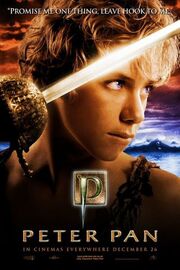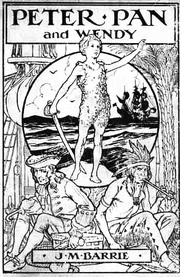
Peter Pan
Peter Pan is a character created by J. M. Barrie (1860–1937). A mischievous boy who can fly and magically refuses to grow up, Peter Pan spends his never-ending childhood adventuring on the island of Neverland as the leader of his gang the Lost Boys. In addition to two distinct works by Barrie, the character has been featured in a variety of media and merchandise, both adapting and expanding on Barrie's work
Appearance
Peter Pan
Barrie never described Peter's appearance in detail, even in the novel Peter and Wendy, leaving much of it to the imagination of the reader. Barrie mentions in "Peter and Wendy" that the character still had all of his baby teeth. He describes him as a beautiful boy with a beautiful smile, "clad in skeleton leaves and the juices that flow from trees". In the play, Peter's outfit is made of autumn leaves and cobwebs.
Traditionally the character has been played on stage by an adult woman.
Age
Peter Pan 1953
The notion of a boy who would "never grow up" was based on J. M. Barrie's older brother who died in an ice-skating accident the day before he turned 14, and thus always stayed a young boy in his mother's mind.
Peter Pan has, however, appeared as a variety of ages. In The Little White Bird he was only seven days old and although his age is never clearly stated in the play of the novel it is clear he's several years older than he was in The Little White Bird. Though, it's stated that Peter still has all his baby teeth.
Personality
Peter Pan in HOOK.
Peter in the original play and novel is a bit of a daredevil and heartless, as little children are. He is a boastful and careless boy to the extreme. He even congratulates himself on something Wendy did, naturally offending her. Peter is cocky and has a devil-may-care attitude. He takes things way too far, but doesn't realize it because he's a child, such as when his "game" with Hook went too far and he cut off his hand and then fed it to a crocodile.
Barrie writes that when Peter thought he was going to die on Marooner's Rock, he felt scared, yet he felt only one shudder run through him when any other person would have felt scared up until death. With his blissful unawareness of the tragedy of death, he says, "To die will be an awfully big adventure".
There's also a dark playful side to Peter, that's only hinted at in the book. Barrie stated in the novel that Peter would "thin the Lost Boys" out when they got too old or when there was too many of them (meaning he may exile or kill them), and sometimes in battles against pirates Peter would switch sides just for the fun of it. It's also stated in the book that Peter would go out and "hunt pirates" for fun.
In Peter and Wendy, Barrie states that the Peter Pan legend Mrs. Darling heard as a child was that when children died, he accompanied them part of the way to their destination so that they would not be scared. That is very much in line with the Victorian obsession with child death in literature.
Abilities
In the chapter 'The Mermaid Lagoon' in Peter and Wendy, Barrie writes that there is almost nothing that Peter cannot do.
☀
- Peter's archetypal ability is his un-ending youth.
- Peter's ability to fly is explained a bit. In The Little White Bird he is able to fly because he is – like all babies – part bird. In the play and novel, he teaches the Darling children to fly using a combination of "lovely wonderful thoughts" and fairy dust; it is unclear whether he is serious about "happy thoughts" being needed, or whether he requires the fairy dust himself. In Hook, the adult Peter is unable to fly until he remembers his 'happy thought'.
- Peter has an effect on the whole of Never Land and its inhabitants when he is there. Barrie states that although Never Land appears different to every child, the island "wakes up" when he returns from his trip to London.
- He is a skilled swordsman, rivaling even Captain Hook, whose hand he cut off in a duel. He has remarkably keen vision and hearing.
- He is skilled in mimicry, copying the voice of Hook, and the tick-tock of the Crocodile.
- In both Peter Pan and Wendy and Peter Pan in Scarlet, there are various mentions of Peter's ability to imagine things into existence, such as food, though this ability plays a more central role in Peter Pan in Scarlet. He also creates imaginary windows and doors as a kind of physical metaphor for ignoring or shunning his companions.
- He is said to be able to feel danger when it is near.
Relationships
Peter does not know his parents. After returning to find his window barred and them with a new baby he assumed they didn't want him and flew away.
- Peter is the leader of the Lost Boys, a band of boys who were lost by their parents, and came to live in Neverland. He is best friends with Tinker Bell, a common fairy who is often jealously protective of him.
- His nemesis is Captain Hook, whose hand he cut off in a duel. Hook's crew, including Smee and Starkey, also consider him a foe. However, Peter forgets who Captain Hook is after Hook is killed.
- From time to time Peter visits the real world, particularly around Kensington Gardens, and befriends children there. Wendy Darling, whom he recruited to be his "mother", is the most significant of them; he also brings her brothers John and Michael to Never Land at her request. He later befriends Wendy's daughter Jane, and Peter and Wendy says that he will continue this pattern indefinitely.
- Peter appears to be known to all the residents of Neverland, including the Indian princess Tiger Lily and her tribe, the mermaids, and the fairies.
Origins

Peter Pan and Wendy by J.M. Barrie
Peter Pan first appeared in J. M. Barrie's 1902 novel The Little White Bird. Later on, in 1904, the chapters containing Peter were re-published under the name Peter Pan in Kensington Gardens. The character of Peter Pan is best known for his appearance in the 1904 stage play Peter Pan, or the Boy Who wouldn't Grow Up. The play was later published as a novel Peter Pan and Wendy and eventually just shortened to Peter Pan.
Appearances
-- Peter Pan in Kensington Gardens - a baby Peter flies from his home, be-friends fairies, and lives in Kensington Gardens. A "book-within-a-book" first published in Barrie's The Little White Bird.
Adaptations
Peter Pan has appeared in various adaptations, sequels, and prequels, including the 1953 animated feature film Walt Disney's Peter Pan, stage musicals, live-action feature films Hook (1991), Peter Pan (2003), and Neverland (2011) and the authorized sequel novel Peter Pan in Scarlet (2006). The character has also appeared in works not authorized by the holders of the character's copyright, which has lapsed in most parts of the world.
A major new stage production that will tour internationally was performed in summer 2009 in Kensington Gardens in a specially built theatre pavilion within view of the Peter Pan statue. The production opens in the US in May 2010.
Peter Pan's origin story is that he fell out of his pram as a baby, came to his window and thought he had been forgotten by his parents because they had a new baby. All of that is what causes his fear of parents and growing up.
In the upcoming stage musical, he will be played by Liam Doyle.
Peter Pan (musical) Cast Lists
Appearances in other adaptations
Peter Pan (Disney film), Return to Never Land
- Main article: Peter Pan (Disney character)
Hook
Peter has grown up, forgotten about his life in Never Land, and has a wife and children. While the family is in London visiting elderly Wendy, Captain Hook abducts Peter's children to lure him back for a final duel to the death. A film by Steven Spielberg.
Peter and the Starcatchers Series
Peter leaves a London orphanage for a series of adventures which offer an origin story for Captain Hook, fairies, his abilities, and the Lost Boys. Novels by Dave Barry and Ridley Pearson.
Peter Pan in Scarlet
Wendy, John, and most of the Lost Boys return to Neverland, where Peter has begun to take Captain Hook's place. A novel by Geraldine McCaughrean, an official sequel to Peter and Wendy
Dylan and the Dream Pirates
Dylan recovering from the death of his mother has an accidental meeting with the mythical Lost Boys which throws him into a world of magic and wonder. When he discovers that his best friend Clay has a magical disease called the Taint, Dylan swears to risk everything to help him and learns along the way that maybe rushing into adulthood isn’t the best plan. There’s also pirates, talking cats, living ships, giant snakes, vampires, and other weirdness.
Robot Chicken
Peter, Hook, Wendy, John, Michael, Crocodile, George, Mary, Nana, Lost Boys, Mermaids, Hook's Pirate Crew and Tinkerbell all appear in Robot Chicken a Adult American stopmotion show. There was one Episode with Peter Pan, Lost Boys, Mermaids, Tinkerbell and Hook's Pirate Crew grew penis' by Bryan Mills
Peter Pan (2003 film)
- Main article: Peter Pan (2003 character)
Neverland (2011 TV film)
- Main article: Peter Pan (2011)
Once Upon a Time
- Main article: Peter Pan (Once Upon a Time)
Physical attributes and age in other adaptations
- In the film Hook, when Peter Banning realizes he is "The Pan" he wears an outfit similar to the Disney film's Pan.
- Peter left Neverland many years earlier and started aging normally. When remembering his long forgotten past, Peter is shown as a baby, and little boy, and also a pre-teen, suggesting that the aging process does not entirely stop in Neverland until puberty or just before. When Peter says "I remember you being a lot bigger," in the final duel, Hook answers, "to a 10-year-old I'm huge." He is portrayed by Robin Williams, who turned 40 during the film.
Trivia
- We aren't told exactly why his surname is "Pan", but it's most likely an allusion to the Greek god Pan, who played the panpipes (Peter also plays the panpipes) and probably not a real surname in the usual human sense.
- Peter bears many other similarities to the Greek God Pan, including being wild and untamed, living in the wild, and leading a group of beings similar to him (Peter leads a group of other little boys, while Pan leads a group of Satyrs)
Gallery
Peter Pan/Gallery
